An original intention of Hidden Truths was to relay the changing stories in the public record. Historically, newspaper reports and articles gave the average reader all the information they may likely ever know about any given topic. Today, newspaper companies employ fact checkers and publish corrections of errors in previously written reports.
My initial research involved reading newspaper articles that addressed questions about the earlier incarnation of Lincoln Park, and the curiosity that was the Couch Tomb. I was struck by my recognition of familiar information, and then noticed newer information that seemed to come from the writer's imagination, or appeared to be an adaptation of an earlier story that may have embellished an even earlier one.
No one has ever appeared to know exactly why the Couch Tomb remains in Lincoln Park, or how many people are at their final rest within it.
Speculation abounds.
_____________________________________________________
Chicago Daily Tribune, February 11, 1892
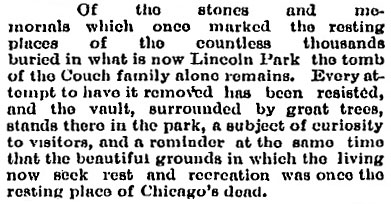
Chicago Daily Tribune, April 25, 1896,
Excerpt from article about Reverend Robert Collyer, who left Chicago in 1879,
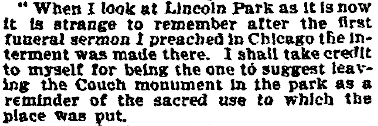
from Report of the Commissioners, and A History of Lincoln Park,I.J. Bryant, 1899,
"There still remains in the southeastern corner of the Park a conspicuous monument of the former uses to which the land was put, the old Couch burial vault. It was found that, because of the nature of its construction, it would be impossible to remove the vault, except at great expense, and the Commissioners preferred to allow it to remain as a not uninteresting reminder of the Park’s origin."
Chicago Daily Tribune, December 23, 1899,
Excerpt from Ira Couch's widow's obituary,
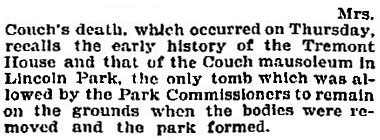
Chicago Daily Tribune, October 7, 1900
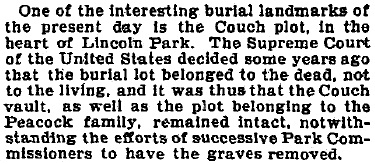
Chicago Daily Tribune, June 2, 1912
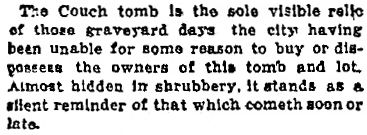
Chicago Tribune, December 10, 1937
(unsigned “A Line O’ Type Or Two” column)
"Legends of why the couch tomb stands in Lincoln park are many, but the real reason, we can assure you is this: Its great stones are fastened together with copper rivets, so that there’s no way of dismantling and moving it without blowing it up or wrecking it completely. The Illinois Supreme court thought that over and ruled it might remain when the graves were removed from the old cemetery originally there to make room for the park.”
Chicago Tribune, May 6, 1951
(from ”Forgotten Man Sleeps in Couch Resting Place,” unsigned article)
“Why does the crypt remain in the heart of a public park?
There are two stories. One is that the United States Supreme court ruled sometime in the late 1800s that burial plots belonged to the dead, not the living. The other, as found in a “History of Lincoln Park,” published in 1899 by the park board, is that because of the vault’s massive construction it would have cost too much to move.”
Chicago Tribune, August 2, 1960
(from article, “Lincoln Park Tomb is Given Spruce-Up Job,” by George Schreiber)
“Most of the park’s south end was a 19th century cemetery, and bodies were moved from the park to other locations to permit the ground to be used for recreation purposes. But the Couch family fought the move and the vault was allowed to remain.”
Chicago Tribune, February 14, 1965
(unsigned “Our Town” column)
“It is not clear whether the Couch vault was allowed to remain because the family fought the move, or because the crypt’s massive construction would make moving too costly.”
Chicago Tribune, August 1, 1969
(unsigned “Action Express” column)
“In 1865, the land was taken over for Park district use, and the district paid to move all graves but one to outlying cemeteries. The exception was the grave of Ira Couch, a pioneer in the hotel business in Chicago whose burial vault was considered too large to be moved easily and without damage to it.”
Chicago Tribune, November 15, 1975
(This is my favorite account. There is a degree of falsehood in every sentence of this reply to a question about the tomb in the newspaper’s unsigned “Action Line” column. Most blatantly, Ira Couch’s date of death is off by five years, and the Couches never had any real estate interest in Lincoln Park, other than the patch of land upon which the tomb rests.)
“Ira Couch’s tomb still stands there for a number of reasons. The principal one was that the family took the issue to the courts in 1865 when the graves were being moved to Rosehill Cemetery. Ira and his brother had owned the city’s large hotel and tavern, the Tremont House. Ira died in 1852. His family contributed the land to make Lincoln Park a cemetery but had retained full deed to the property under the mausoleum. The United States Supreme Court in the meantime declared that graves belonged to the dead and not the living.”
Chicago Tribune, October 13, 1977
(unsigned “Action Line” column)
“In a fall, 1972, article in Chicago History Magazine, author John Clayton quotes several sources to show that Ira Couch’s descendants could not agree on how many bodies actually were in the mausoleum. Furthermore, despite many versions as to why the tomb remained in the park when the others were moved, he could find no written records. He finally concluded it was simply by a gentleman’s agreement between Couch’s brother, James, and the Park Board."
Chicago Tribune, June 18, 1978
(from "Lincoln Park's Statuary: A quick trip through history." Kenan Heise)
“When the graves were moved to turn the land into a park, Couch’s tomb remained, apparently because of a “gentleman’s agreement” with park district board members.”
Chicago Sun-Times, September 27, 1982
(a “question from readers” column, like the Tribune’s “Action Line,” unsigned)
Lincoln Park was once Rosehill Cemetery. ... In 1866 the city wanted to transform the cemetery into a park. Further burials were halted, graves were moved and plot owners sold their land to the city. But the Park district, low on funds, couldn’t afford to move the massive Couch edifice. In fact, the door had rusted shut and couldn’t be opened. The family seized the opportunity to challenge the plans to either move or tear down the vault and won the case in court. However, the settlement also denied the family the right to maintain it. So the memorial continues to sit unattended.”
Chicago Tribune, April 19, 2002
(from "Tales of the Crypt," Lou Carlozo)
"As for why Couch's mausoleum stayed when almost every other body left, no one seems to know for sure. One theory, perhaps the most plausible, is that the structure was simply too big to dismantle or move. Another has it that James used his muscle with city bigshots to keep his brother in Lincoln Park."
Chicago Tribune, January 4, 2004
(from "Stop Signs; 20,000 bodies were once buried in Lincoln Park. Who's still there," Rick Kogan)
"Some think the mausoleum was too large to move. Others think political clout was involved."
______________________________________________
During my year of research, I found a now-defunct Web Site selling sheet music by a composer named Daniel P. Wade. The paragraph below describes the piece for solo flute, titled "The Mystery of Ira Couch."
"This three movement work (I. Mausoleum, II. Ira, III. Enigma) is an exploration into the life and times of Ira Couch, Chicago's first hotel baron. Mysterious, lyrical, and evocative, "The Mystery of Ira Couch" takes listener and performer from the present day mystery surrounding a lone mausoleum in a public park to the enterprising life of Ira Couch, ending with the enigmatic question of his final resting place."
|